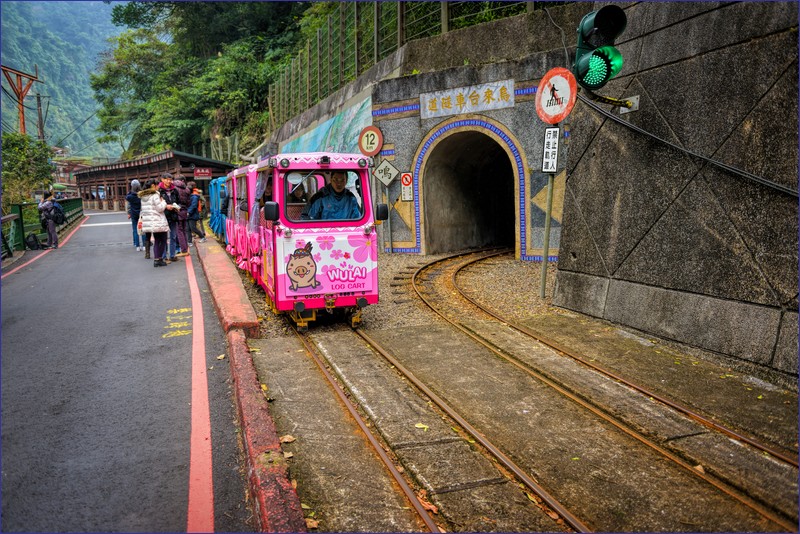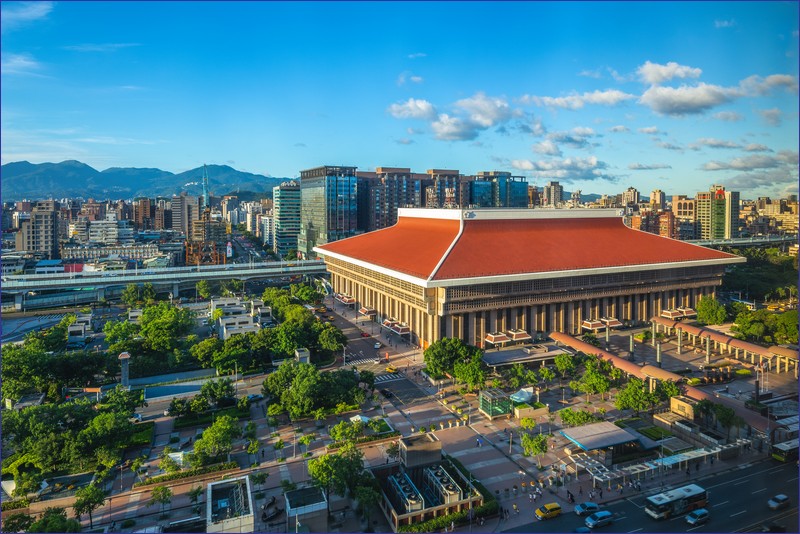Trains are an important means of transportation in Taiwan. The first railway line, built in 1891, connected Taipei and Kee Lung (29 km). In 2007, the Taiwan High-Speed Rail line between Taipei and Kaohsiung was opened. Taiwan has two main railway lines along the western coast and one along the eastern coast. The western line has several branches. Train travel in Taiwan allows you to reach major cities; however, buses reach almost everywhere, are cheaper than trains, and offer a high standard. Nevertheless, trains in Taiwan remain a popular form of transport due to their frequent service.
Last updated: 30.06.2025
Train travel in Taiwan – basic Information
Passenger trains in Taiwan are operated by two providers:
Taiwan Railway Administration (TRA) operates both passenger and freight trains. It is a government-owned operator responsible for commuter, regional and intercity trains.
Taiwan High-Speed Rail Corporation (THSRC) operates the High-Speed Rail line between Taipei and Kaohsiung, which is about 350 km long. The fleet consists of Shinkansen 700 trains manufactured in Japan. Trains on this route reach speeds of up to 300 km/h. The operator offers promotional Early Bird tickets, which allow discounts of up to 35%. For tourists, there are two-day (any two days within a seven-day period) and three-day (three consecutive days) unlimited travel passes for the Taipei–Kaohsiung high-speed line.
Tailwan Railway – official website
Taiwan High Speed Rail Corporation – official website

Taiwan Pass
Tourists traveling in Taiwan can purchase a Taiwan Pass, a network ticket available in several versions — valid for 3 or 5 days, either for use only on Taiwan Railway trains or also including High-Speed Rail services. Additionally, you can choose a version that includes one of the metro systems, selected bus routes, or one of the tourist railways. The pass is available exclusively to foreign visitors.
Tickets can be purchased electronically. For those who have never traveled in Taiwan before, determining the scope of validity and how to use the ticket can be quite challenging.
Prices are affordable.
Taiwan Pass – official website

Tourist lines and trains
Several tourist trains operate in Taiwan. The most famous is the Alishan Forest Railway.
Authors of the travel guides primarily focus on the High-Speed Rail line and the parallel north-south route used by “regular” trains. This second line has three branches that pass through scenic areas highly attractive to tourists. These lines have a special fare structure. Travel reports often emphasize the beauty of these routes and the nostalgic atmosphere, making passengers feel as though they’ve been transported back in time.
Neiwan Line – the approximately 25-kilometer-long line between Hsinchu and Neiwan is one of Taiwan’s most popular tourist attractions. Services are operated by air-conditioned diesel multiple units. A one-way trip takes around 50 minutes, with an average train speed of 30 km/h. Two direct train pairs between Taipei and Neiwan run daily. In Hsinchu, visitors can explore the culture, lifestyle, and traditions of the local Hakka ethnic group.
Pingxi Line – like the Neiwan Line, this railway was originally used to transport coal. The 12.9-kilometer-long line was built in 1921 by the Japanese. The route includes numerous tunnels and bridges, and in two towns, trains pass right through the main commercial streets (Old Street). The line is easily accessible from Taipei, though train frequency is limited. According to travel websites, you can reach the line by taking a suburban train (Taipei Railway) from Taipei Station to Ruifang (about 40 minutes) or Houtong, where you can transfer to the Pingxi train.
Two stations along the line are particularly noteworthy:
Jingtong – in the early 20th century, it was a thriving mining town. Today, its mining museum commemorates that era. Attractions include the 1931-built train station, a small railway museum, and the aforementioned Old Street.
Shifen – Near the station, you can visit beautiful waterfalls (some visible from the train line). The area offers well-maintained, clearly marked hiking trails perfect for long walks. Another highlight is the town’s suspension bridge.
Jiji Line – this line runs from Ershui to Jiji, and optionally to Checheng. Also built by the Japanese, it is now served by air-conditioned multiple units running every two hours. Unlike the other lines, this one is not particularly scenic, yet it remains very popular with tourists. The town of Jiji and its surroundings were once damaged by an earthquake, but it has since become a favorite destination.

Alishan Forest Railway
Taiwan is home to a true gem among railway attractions — a unique forest railway.
What makes this railway exceptional is its gradient — it begins in Chiayi at an altitude of 30 meters above sea level and ends in Alishan at 2,274 meters above sea level. The journey along the approximately 86-kilometer route takes 3.5 hours. Due to the steep incline, the track runs in a zigzag pattern in many sections. Along the way, the train crosses 77 bridges and passes through 49 tunnels. The railway was built in 1912 by the Japanese.
Currently, there are two train pairs running daily — one early in the morning and the other in the evening. Trains consist of four passenger carriages pulled by a diesel locomotive.
Alishan Forest Railway – official website

Taipingshan Railway
A beautiful photo circulating online shows railway tracks resembling a foggy path in a mysterious park. Curious viewers often ask whether trains actually run on those tracks. While trains do not operate on those exact rails, the photo comes from Taipingshan Park, where a tourist train does run.
The Taipingshan Bong Bong Train is a scenic tourist train that runs on a short 3-kilometer track. The full historic forest railway network once stretched over 30 kilometers. The journey from Taipingshan Villa to Maosing Station takes about 20 minutes. Visitors sitting in the open-air cars of the diesel-powered train can enjoy breathtaking views of the surrounding mountains and forests up close.
Taipingshan Bong Bong Train – official website
Wulai Mini-Train
Narrow-gauge tourist train on the former forest railway from the village of Wulai, Wulai District, New Taipei City, to the nearby waterfall. Total length of the route is 1.5 km. The train is comprised of open sided carriages and it runs relatively fast.

Wushulin Park Railway
One of the preserved Taiwanese sugar railways converted into a tourist line is the narrow-gauge train operating in Wushulin Recreation Park, located on the site of a former sugar factory in Tainan. The train travels a short route through the fields, allowing passengers to enjoy the variety of plants along the tracks, as well as the birds and insects living there. The train is usually diesel-hauled, though the SL-370 steam locomotive is occasionally used.
Wushulin Sugar Railway Cultural Park – official website
Other Sugar Railways
In addition to the railways mentioned above, there is limited information available about two other sugar railways. The first is the Xin Ying line. The sugar refinery there ceased operations in 2001, and two years later a cultural institution was established to preserve its heritage. It has become something like a museum of the region’s sugar industry history. The Xin Ying line was 4.6 kilometers long. There are reports that a tourist train runs on this line, but this information could not be confirmed.
Another tourist train reportedly operates at the Qiaotou Sugar Refinery. There is also a train in Hsi-Hu, though again, detailed information about this line is lacking.
Miaoli Railway Museum
The history of railways in Taiwan can be explored at the Miaoli Railway Museum, located near the Miaoli train station. The pride of the museum is its collection of locomotives, the oldest of which was built in 1910. Visitors can see a wide range of steam and diesel locomotives — some once used for passenger transport, others on sugar railways. The exhibition is complemented by a rich collection of artifacts documenting Taiwan’s railway history. In 2025, the museum reopened after an extensive renovation. It now spans an area of nearly two hectares. The museum does not have an official website.
Miniature Railway in Shengxing
The Shengxing Station was built in 1906. Due to its distinctive appearance, it is a very popular tourist attraction, frequently featured in travel brochures and often used as a photo shoot location for newlyweds. Nearby, there is an abandoned railway tunnel.
The last train stopped at the station on September 23, 1998. Recently, a miniature railway was built at the station, where visitors can ride a short loop track. The miniature trains are pulled by small-scale locomotives — a black one modeled after a steam locomotive, and a red one powered by electricity.
The station also displays artifacts from the Japanese occupation era.
According to English-language sources, Shengxing can be reached by taxi from Sanyi.
Related articles:
